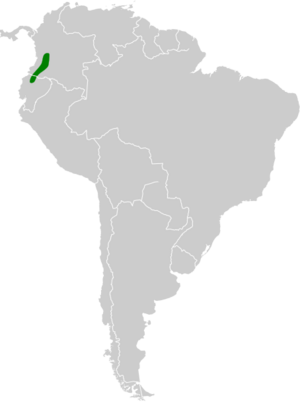Blue-headed sapphire facts for kids
Quick facts for kids Blue-headed sapphire |
|
|---|---|
 |
|
| Colombia | |
| Conservation status | |
| Scientific classification | |
| Genus: |
Chrysuronia
|
| Species: |
grayi
|
 |
|
| Synonyms | |
|
|
The blue-headed sapphire (Chrysuronia grayi) is a beautiful hummingbird found in Colombia and Ecuador. It's also sometimes called Gray's hummingbird. These tiny, colorful birds are known for their fast wings and love for flower nectar.
Contents
About the Blue-headed Sapphire
What's in a Name?
Scientists often change how they group animals as they learn more. The blue-headed sapphire was once placed in different bird groups, called genera, like Hylocharis and Amazilia. But after a special study in 2014, most scientists decided it belongs in the Chrysuronia group. This helps us understand how different birds are related!
The blue-headed sapphire is a "monotypic" species. This means it doesn't have any different types or subspecies within its own group.
What Does It Look Like?
The blue-headed sapphire is a small bird, about 9 to 11 centimeters (3.5 to 4.3 inches) long. That's about the length of your hand!
Male hummingbirds are a bit heavier than females. Males weigh about 6.2 to 6.8 grams (0.22 to 0.24 ounces). Females are lighter, at 4.6 to 5.6 grams (0.16 to 0.20 ounces).
Male and Female Differences
Males have a bright, straight bill that's coral red with a black tip. Females have a black upper bill and a mostly pinkish lower bill with a black tip.
Adult males are very striking! They have a shiny, deep blue color on their upper throat, face, and the top of their head (crown). Their neck is dark blue-green, and the rest of their upper body is a metallic green. Their tail is a dark steel blue. Their chest and upper belly are a sparkling emerald green, with a small white patch on their lower belly.
Adult females have metallic green to bronze-green on their upper parts. Their tail is dark bronze-green at the base and blue-black towards the end, with grayish tips on the outer feathers. Their underside is mostly dull white or grayish white. They have some bronze-green on the sides of their throat and chest.
Young Hummingbirds
Young male hummingbirds have a dull bluish-green face and crown. Their throat and chest are bronzy green, and their belly is grayish white. Young females look similar but are duller and more bronzy overall.
Where Do They Live?
The blue-headed sapphire lives in the valleys between the Andes mountains. You can find them from western Colombia all the way south into Ecuador.
They like dry, bushy areas and the edges of woodlands or taller forests. They can also be seen in areas where people grow crops. These birds usually live at elevations between 500 and 2000 meters (1,600 to 6,600 feet) above sea level. Sometimes, they can even be found as high as 2600 meters (8,500 feet)!
Hummingbird Behavior
Do They Move Around?
Scientists think blue-headed sapphires move to different places depending on the season. However, we don't know much about their exact travel plans yet.
What Do They Eat?
Blue-headed sapphires mostly drink nectar from many different kinds of flowering shrubs and trees. Nectar is a sweet liquid that gives them energy.
Sometimes, they will protect their favorite feeding spots from other birds. When several of them gather at a flowering tree, they can be quite "aggressive" towards each other! Besides nectar, they also eat insects. They catch insects by flying out from a perch (a branch they sit on) or by picking them off plants.
How Do They Sing?
The blue-headed sapphire has a special song! It's a repeated short, warbling sound that starts with a squeaky "tee" note. It sounds like "tee…teetlitlitsee-chup… teetlitlitsee-chup." They also make short "chip" notes and a high-pitched, rattling sound that goes down in pitch.
When Do They Have Babies?
We know that blue-headed sapphires are ready to breed between November and April. However, there isn't much other information about their breeding habits. For example, no one has ever described what their nest looks like!
Conservation Status
The IUCN (International Union for Conservation of Nature) has listed the blue-headed sapphire as a species of "Least Concern." This means they are not currently in danger of disappearing.
Even though their population size is unknown and might be decreasing, no specific threats have been found. These hummingbirds seem to be able to live in areas that have been changed by humans, like open fields or cultivated farms. This helps them survive even when their natural habitat changes.


